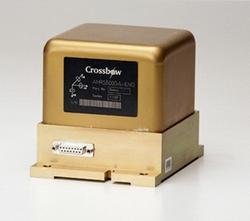Wed, Feb 26, 2003
 Crossbow Technology has just received FAA
certification for the AHRS500GA, the first stand-alone
micro-electro-mechanical system (MEMS) attitude heading reference
system (AHRS). Stand-alone means the Crossbow AHRS operates
independently and does not require Air Data or GPS inputs for
correct operation.
Crossbow Technology has just received FAA
certification for the AHRS500GA, the first stand-alone
micro-electro-mechanical system (MEMS) attitude heading reference
system (AHRS). Stand-alone means the Crossbow AHRS operates
independently and does not require Air Data or GPS inputs for
correct operation.
Only Standalone FAA Certified MEMS AHRS
The Crossbow AHRS500GA is a high performance, solid-state
attitude and heading reference system intended for general aviation
aircraft. This high reliability inertial system provides attitude
and heading measurement with static and dynamic accuracy superior
to traditional spinning mass vertical and directional gyros. Dean
Johnson, Vice President for Inertial Systems, says "Crossbow is the
first to offer the General Aviation pilot the reliability of
solid-state MEMS sensors in a low cost AHRS that meets all the FAA
TSO certification requirements. The AHRS500 is designed for the
future and has passed the tough new multiple lightning strike test
as part of its qualification testing."
Automotive Sensor Technology Harnessed
 The sensor technology of the AHRS500 was developed
for the automotive industry, which makes the technology highly
reliable and potentially affordable for general aviation pilots.
The raw performance of these devices is geared toward fairly coarse
inertial applications, such as skid detection. John Crawford, vice
president of sales for Crossbow, says "Crossbow started with the
automotive industry's low-cost, highly reliable, but low-performing
sensors and invested six years,of R&D in calibration
approaches, packaging, software algorithms and environmental
design. The result is a flight-proven AHRS that requires no
additional or aiding input from Air Data or GPS to meet FAA
performance requirements. That is the real breakthrough here."
The sensor technology of the AHRS500 was developed
for the automotive industry, which makes the technology highly
reliable and potentially affordable for general aviation pilots.
The raw performance of these devices is geared toward fairly coarse
inertial applications, such as skid detection. John Crawford, vice
president of sales for Crossbow, says "Crossbow started with the
automotive industry's low-cost, highly reliable, but low-performing
sensors and invested six years,of R&D in calibration
approaches, packaging, software algorithms and environmental
design. The result is a flight-proven AHRS that requires no
additional or aiding input from Air Data or GPS to meet FAA
performance requirements. That is the real breakthrough here."
Viable Alternative To Spinning Gyros
In fact, this technology permits general aviation pilots to have
the same attitude and heading benefits of the ring laser gyro-based
INS system in a transport category aircraft. "The difference is
that an INS system may cost upwards of $100,000, but it operates on
the same principle. The AHRS500 provides a new and clear
alternative to unreliable spinning gyros or costly INS systems,"
says Crawford. The AHRS500 also includes a comprehensive built-in
test function, similar to high-end INS systems, that continuously
monitors the AHRS for proper operation.
Crossbow flight testing of the AHRS500 against a high-end
inertial navigation system (INS) proves the accuracy of the AHRS500
is better than that of the vacuum driven gyros in most aircraft.
The AHRS500 is designed to meet all FAA requirements and is
certified to TSO 4 (Bank and Pitch) and 6 (Heading).
More News
Also: USAF Pilots, Atlanta Tower Evac, Archer Spotlight Dissipates, Hop-A-Jet Sues A social-media call for people to point lasers at aircraft flying over Portland’s ICE facil>[...]
Also: Kodiak 100 Joins USFS, Innovative Solutions & Support Renamed, Gulfstream Selects Honeywell, Special Olympics Airlift The Phantom 3500 mockup made an appearance where the>[...]
"On the way back to the United States from NATO’s Defense Ministers meeting, Secretary of War Hegseth’s plane made an unscheduled landing in the United Kingdom due to a>[...]
Pilot Was Transporting His Family Back To Their Home In Boise And He Planned To Fly Back To SHR That Afternoon On September 1, 2025 about 1612 mountain daylight time, a Piper PA-28>[...]
How To Get A Story On Aero-TV News/Feature Programming How do I submit a story idea or lead to Aero-TV? If you would like to submit a story idea or lead, please contact Jim Campbel>[...]
 Airborne 10.14.25: Laser Threat, VeriJet BK, Duffy Threatens Problem Controllers
Airborne 10.14.25: Laser Threat, VeriJet BK, Duffy Threatens Problem Controllers Airborne 10.15.25: Phantom 3500 Confounds, Citation CJ3 Gen2 TC, True Blue Power
Airborne 10.15.25: Phantom 3500 Confounds, Citation CJ3 Gen2 TC, True Blue Power Aero-News: Quote of the Day (10.17.25)
Aero-News: Quote of the Day (10.17.25) NTSB Prelim: Piper PA-28-180
NTSB Prelim: Piper PA-28-180 ANN FAQ: Contributing To Aero-TV
ANN FAQ: Contributing To Aero-TV




